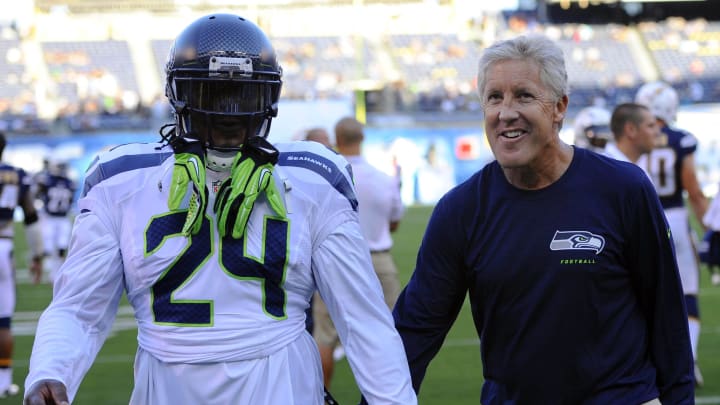'I Kept Fighting': Pete Carroll Details Seattle Seahawks 2010 Marshawn Lynch Trade

Trading for Marshawn Lynch was one of the Seattle Seahawks’ most transformative roster moves in franchise history.
Lynch, the 12th overall pick in 2007 by the Buffalo Bills, became a fan-favorite on and off the field in Seattle. The Seahawks traded for him on Oct. 5, 2010, and the “Beast Quake” occurred at Lumen Field (Qwest Field at the time) just over three months later — beginning a legendary career that concluded with Lynch as the franchise’s fourth-leading rusher all-time (6,381 yards).
The all-time ranks don’t fully explain Lynch’s total impact on the franchise, however. He was — and still is — a larger-than-life personality who backed up everything he said on the field. Lynch ran the ball with a distinguished level of paced ferocity that seemingly no other running back can replicate, then proceeded to shower himself in Skittles candy on the sideline.
Lynch was one of many influential players on the 2010s Seahawks teams that were defined by the Legion of Boom defense. But former Seahawks coach Pete Carroll said the trade almost didn't happen.
In a recent appearance on the Politickin’ podcast with California Governor Gavin Newsom, NFL agent Doug Hendrickson and Lynch, Carroll broke down the transaction.
“[Buffalo was] hard on us. They didn’t want to trade him, but they knew that they kind of needed to,” Carroll said. “To me, it was so important … I’d never pursued anybody like that. It was so important because I wanted his attitude and his make-up on the team because we were a down-and-out club at the time. We hadn’t done anything the last few years before I got there, and it was time to see if we could turn it.”
Lynch spent three full seasons in Buffalo from 2007–09 and started three games for the Bills in 2010 before being traded. He posted two 1,000-yard seasons but also dealt with legal troubles that included a hit-and-run charge in 2008 and a misdemeanor weapons charge in 2009. He was suspended three games to begin the 2009 season as a result of the latter incident.
Lynch only started six games for the Bills in 2009. Fred Jackson supplanted him as the team’s starting running back after Lynch rushed for more than 1,000 yards each of the last two seasons.
Regardless of Lynch’s troubles, the Bills spent a first-round pick on him. He rushed for 3,230 yards in three seasons at the University of California, Berkeley to become the program’s second-leading rusher all-time. Buffalo knew what it had, but didn’t know how to handle it.
Carroll, who admitted he missed Lynch in recruiting while he was the head coach at USC, was going to stop at nothing to acquire him. Trade talks proceeded for three months before a deal was made — dating back to training camp before the 2010 season.
“I can’t even tell you why it was so obvious to me, because nobody else saw — [general manager] John [Schneider] and the guys in the building didn’t see it the same way. But that’s why I kept fighting for [Lynch].”
Once the trade was complete, Lynch had a fresh start with the Seahawks. Seattle sent Buffalo a 2011 fourth-round pick and a 2012 conditional pick that became a fifth-rounder.
“Remember at that point in time, a lot of [expletive]’s had counted me out … So to go from being on the sideline in street clothes [in Buffalo] to the beast quake, that’s some belief in a [expletive], though.”
Lynch went on to be a defining player in the locker room for Seattle, as Carroll embraced his personality instead of trying to combat it, Carroll said. As a result, Lynch thrived on the field and rushed for 57 touchdowns over the next seven seasons (66 total scores in his Seattle career).
He earned four Pro Bowl nods and two All-Pro honors with the Seahawks, rushing for 1,257 yards and 12 touchdowns in Seattle's Super Bowl-winning campaign in 2013. Lynch rushed for a career-high 1,590 yards the season prior.
Lynch will be on the Pro Football Hall of Fame ballot in 2025 after permanently retiring after the 2019 season.
“The rest is history,” Carroll said. “And so it was really the most important move that we made in making the statement of the kind of team we wanted to be and the kind of personalities we wanted to jump around and play with. It really was huge.”
